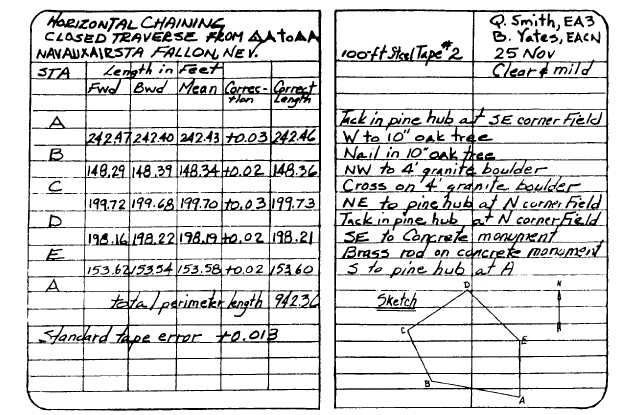Preparing Chaining Notes
Before discussing the subject of chaining
notes, we will mention a few general principles
applicable to all types of field notes. It goes
without saying that it is essential that measure-
ments and other data be accurately recorded and
that any additional information required to
identify and clarify the data be included.
Field notes are required to be legible as well
as accurate. If you don’t write or print legibly,
you will have to improve your script. All notes
should be recorded in pencil; a 3H or 4H pencil
is best for the job. A pencil that is too soft blunts
too quickly; one that is too hard makes a faint
mark and scores the paper. In the field, you need
to carry a pocketknife or pocket pencil sharpener
to keep your pencil sharpened or pointed.
There is a general rule to the effect that
erasures are not permitted in field notes. Suppose
that in the course of chaining several intervals you
make a 10-ft “bust” in one of the intervals by
misreading 10 ft as 20 ft. After you total up the
distance, some circumstance leads you to suspect
that the total is off. You recheck the work and
discover where you made the bust. The notebook
record for that interval must be changed. You
make the change by crossing out the wrong entries
and entering the correct ones above them—not
by erasing the wrong entries.
RECORDING NOTES FOR HORIZONTAL
CHAINING.— A typical example of a horizontal
chaining conducted for a closed traverse is shown
in figure 12-16. The chaining party started at
station A and chained around by way of B, C,
and so on. Arriving back at A, the party reversed
its direction and chained back around by way of
E, D, C, and so on, as a check. The distance
finally recorded for each traverse line was the
mean (average) between the forward measurement
and the backward measurement.
Note on the bottom left-hand side the fact that
the tape had a standard error of 0.013 ft per 100
ft of tape. The error is marked “ + ,” meaning
that the amount of error should be added to the
measurement as indicated by the tape. Obviously,
the tape was reading short.
The corrections in the “Correction” column
indicate that only correction for standard error
Figure 12-16.-Notes for horizontal chaining.
12-19



